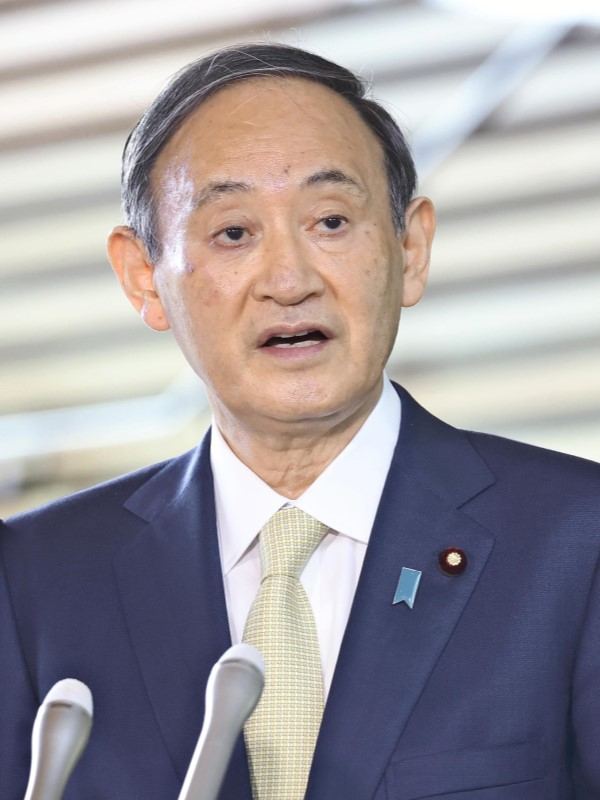
Tanks are seen at the Fukushima No. 1 nuclear power plant on April 7.
16:28 JST, April 14, 2021
The decommissioning of the disaster-hit Fukushima No. 1 nuclear power plant, which will take more than 30 years to complete, moved a step forward with Tuesday’s decision by the government to release treated radioactive water into the ocean.
The tanks holding the water are approaching their limit, prompting the Cabinet of Prime Minister Yoshihide Suga to make its decision, overriding the persistent opposition of local fishermen and others.

Prime Minister Yoshihide Suga answers a reporter’s question at the Prime Minister’s Office on Tuesday.
“Disposal of the treated water is an inevitable issue if we are to proceed with the decommissioning of the Fukushima No. 1 plant and achieve the reconstruction of Fukushima,” Suga stressed Tuesday to reporters at the Prime Minister’s Office after making the decision.
He also admitted that the government could not postpone the decision any longer, saying, “It’s also true that the number of tanks has grown, and the plant site is almost full.”
The ocean release will require screenings and approval from the Nuclear Regulation Authority (NRA) for the installment of pipes and related facilities. It will take about two years before the release can actually be carried out.
There are already 1.25 million tons of treated water at the plant site, and it is estimated to reach its full storage capacity of 1.37 million tons by autumn 2022. This means the government was under pressure to make a decision.
Since his days as chief cabinet secretary under the Cabinet of former Prime Minister Shinzo Abe, Suga has believed that a decision on the treated water should be made swiftly. He began searching for the right time immediately after being sworn in as prime minister in September last year.
Suga had been examining whether October or December last year would be a good time to make the decision, but gave up on this timing due to opposition from the fishery industry.
However, it was judged that an early decision would have less impact on the Tokyo Olympics and Paralympics this summer and the House of Representatives election planned before autumn.
On March 23, Economy, Trade and Industry Minister Hiroshi Kajiyama spoke with International Atomic Energy Agency Director General Rafael Grossi to seek his understanding of Japan’s policy and gain the agency’s cooperation.
On April 7, Suga managed to meet with Hiroshi Kishi, chairman of JF Zengyoren, or the national federation of Japan Fisheries Cooperatives, which has opposed the ocean release. Kishi refused to budge from his stance, but Suga ultimately decided to go through with it anyway.
In response to Tuesday’s decision, Kishi released a statement on the same day, saying: “This is extremely regrettable and unacceptable. We strongly protest.”
Discharge around 2023
Tokyo Electric Power Company Holdings, Inc. is expected to start the discharge around 2023, and the release of the water will continue for more than 30 years. The water has already been treated with special equipment and most of the radioactive materials — except tritium — have already been removed.
According to the government’s basic policy, which was decided Tuesday, the treated water will be diluted 100 to 1,700 times with seawater before being released, and the concentration of tritium per liter will be kept below 1,500 becquerels. This is about one-fortieth of the national standard of 60,000 becquerels for release into the environment, and one-seventh of the World Health Organization’s standard of 10,000 becquerels for drinking water.
As a result, the total amount of tritium released into the ocean throughout the year is expected to be less than the usual amount released in regular operations before the 2011 nuclear accident, and the government is aiming for “safety far exceeding the standard,” as Suga said. The government and TEPCO will heighten water quality surveys at fishing grounds and bathing beaches, and will also provide data to the IAEA for the objective verification of safety.
TEPCO will be responsible for the practical work involved in the release, and will put together a plan for the design of tanks and piping and the operational schedule. After that it will submit an application to the NRA for screenings, which are expected to take about six months.
The basic policy includes the central government taking measures to prevent harm to concerned parties’ reputations and TEPCO being responsible for compensation in the event of harm.
"Politics" POPULAR ARTICLE
-

Japan to Support Central Asian Logistics Route That Bypasses Russia, Plan to Be Part of Upcoming Summit in Tokyo
-

Japan to Tighten Screening of Foreigners’ Residential Status by Providing Information of Nonpayment of Taxes
-

Takaichi Cabinet Approval Holds at 72% as Voters Back Aggressive Fiscal Stimulus, Child Benefits
-

Chinese, Russian Bombers Flew Unusual Path by Heading Toward Tokyo; Move Likely Meant to Intimidate Japan
-

Takaichi Meets Many World Leaders at G20 Debut in Johannesburg; Speaks with Heads of Countries Including Italy, U.K., Germany, India
JN ACCESS RANKING
-

Keidanren Chairman Yoshinobu Tsutsui Visits Kashiwazaki-Kariwa Nuclear Power Plant; Inspects New Emergency Safety System
-

Imports of Rare Earths from China Facing Delays, May Be Caused by Deterioration of Japan-China Relations
-

University of Tokyo Professor Discusses Japanese Economic Security in Interview Ahead of Forum
-

Japan Pulls out of Vietnam Nuclear Project, Complicating Hanoi’s Power Plans
-

Govt Aims to Expand NISA Program Lineup, Abolish Age Restriction






















